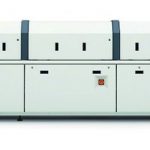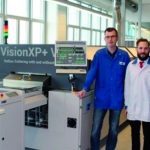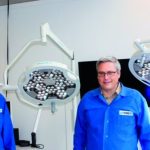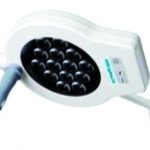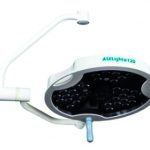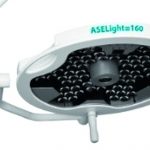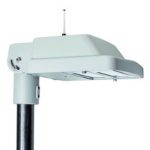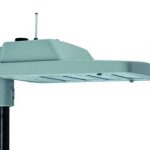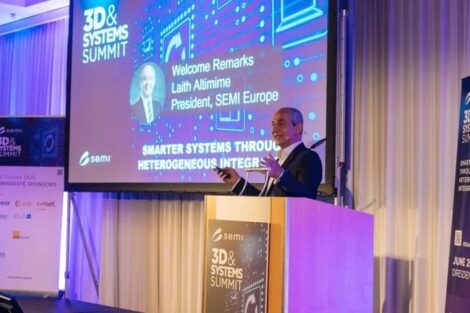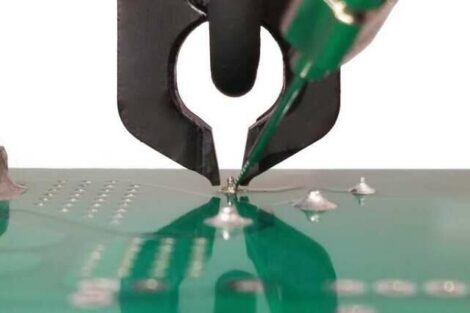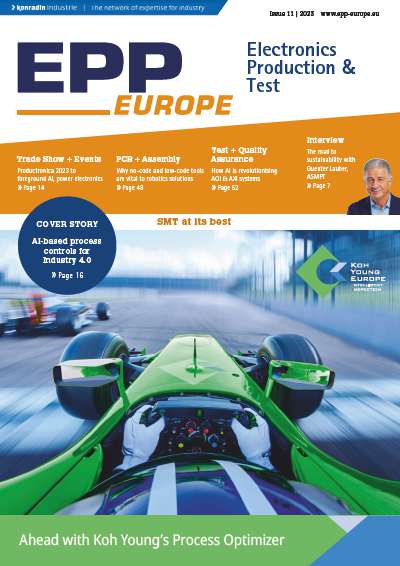In order to assure that this new lighting technology functions flawlessly, heat generated by the LEDs must be reliably dissipated. This is where Asetronics comes in. The company located in Bern, Switzerland, produces and develops modern electronics for LEDs and is continuously researching strategies targeted at improving temperature management. The company has been successful in manufacturing light modules for the automotive industry. Their product range also includes street lamps and railway illumination, work lamps for industry, laboratories and offices, as well as, lamps for surgery and examinations in the field of medical technology – all on the basis of LEDs.
Quality connects: Swiss precision united with German machinery manufacturing
Until 2004, the company belonged to the production division of telecommunications manufacturer, Ascom. In 2006, they successfully launched independent operations with its first LED applications involving chip-on-board technology. These applications are used in the brake lights, blinkers, fog lights, and daytime running lamps of vehicles produced by renowned automobile manufacturers. Asetronics has since experienced strong growth and in the meantime employs 190 persons. Roughly 60 % of the company’s annual turnover is generated alone with LED light modules for automotive headlights. The Swiss enterprise cooperates with suppliers of well-known brand names, such as Audi, BMW, Daimler, and Porsche.
Whereas only premium automobiles were equipped with LED light a number of years ago, cars without this modern lighting technology are now rare. Pressure is rising along with unbelievable growth of the industry sector. The company produces roughly 250 million SMD components each year. They are continuously expanding their product range and production capacity, maintaining high levels of quality, and conducting research targeted towards optimizing their technology. The company relies upon diversified know-how in order to make successful progress in this respect. And this means that they not only assemble and process the light modules, they also manufacture the metal-core PCBs for the LEDs. This makes it possible to optimize heat management and to continue to improve it by means of an in-house R&D.
“In extreme cases, inadequate temperature management can result in irreversible damage or destruction of the LED and the PCB. Light emitting diodes radiate light to the front and heat to the back, which has to be dissipated from the chip as quickly as possible. At temperatures of greater than 150 °C, the sensitive diode degenerates”, explains Georg Schafer, the company’s Head of Turnkey Electronics. There’s a small thermal resistor between the component and the PCB, as well as between the PCB and the heat sink, in order to ensure ideal temperature management. Heat at the bottom can be removed and dissipated via the heat sink with the help of microvias. The heat sink functions in turn via the metal-core PCB with its extremely thin layer made of insulation material, which ideally spreads and dissipates the heat. This is particularly important due to the ever increasing levels of miniaturization.
Where the production of sensitive electronic components is concerned, Asetronics relies on top quality systems engineering from Germany. Over the last three years, in order to reduce maintenance costs and manufacture more efficiently, the company has entirely switched over to reflow soldering systems from Rehm Thermal Systems. Three VisionXP+ convection soldering systems are currently being used in production.
This system, equipped with a vacuum module for reducing voids in the solder joint, has been running since October 2016. Heavy equipment was necessary to bring the 4600 kilogram titan on the upper floor of Asetronics. And the effort has paid off, since vacuum soldering has become a central issue in electronics manufacturing. In order to assure the best possible quality, this became the Swiss company’s standard process. “Vacuum technology is an important issue, in particular where the production of sensitive electronics is concerned. In the meantime, LED manufacturers are demanding void content of less than 15 %. In some cases, the tolerance limit is even lower for certain products. We’re now able to fulfill these requirements reliably, and above all lastingly, with the VisionXP+ Vac”, stresses Sven Schwalbach, the company’s head of the SMT Production department.
This soldering system delivers reliable soldering results, even at high throughput levels. With a partial vacuum of down to 2 mbar, void content of less than 2 % is feasible – a great advantage, above all for future manufacturing requirements. With the help of the optional vacuum module, the user can decide, depending on the respective product, whether or not vacuum technology should be activated. As a result, manufacturing flexibility is greatly increased. “The option for systems networking represents a further advantage. The machines access a common database. And thus it’s possible to run identical profiles on our systems – a point which mustn’t be overlooked with regard to time and saving costs in production”, says Philip Längsfeld, Head of Sales Europe at Rehm Thermal Systems.
Perfect illumination for doctor’s offices and hospitals
The favorable characteristics of LEDs are apparent in the field of medical technology – which is also the mainstay for Asetronics. Outstanding light quality and natural color rendering, full illumination without shadows, intensive and clear light without glare, and high levels of luminance with minimal heat radiation – medical lighting is subject to demanding requirements. Due to the fact that older light sources radiate a great deal of heat to the front, thus causing operating rooms to heat up very quickly for example, the company developed a lighting concept which is advantageous for surgeons. “Our new generation of surgical lighting consists of LEDs which can be individually regulated with regard to brightness, color temperature, and light focus. With the LED, heat is dissipated to the back. And thus in the active state, the lamp is no warmer than 35 to 40 ° C. Light is focused in a bundled fashion – shadow-free and with natural color rendering. Beyond this, the lamp is equipped with an integrated HD camera. These conditions make work much more pleasant for attending physicians and surgery personnel”, says Georg Schafer.
The product range also includes lamps for doctor’s offices in different sizes and variants. Optimum light spread and minimal heat generation assure, for example, that dentists and dermatologists can precisely illuminate the area to be examined without any glare for the patient.
“Light On Demand”: Clever concept for street lamps with a promising future
In 2014, the company successfully participated with the reconceptualization of street lighting in the canton of Bern. The manufacturer’s “Light On Demand” project was highly convincing. They developed a new type of LED light module system to this end for rugged outdoor lamps. Each street lamp is equipped with a motion detector which is capable of controlling light in an event-oriented manner. “When there’s no traffic, lighting power is reduced by 10 to 20 %. If a person or a car approaches, the closest lamp and the next three are pushed up to full power. This results in energy savings amounting from 80 to 90 %, as compared with the inefficient older systems”, says Georg Schafer. A lamp consists of roughly 50 individual LEDs. Not only can they be switched on and off, they’re also individually dimmable. After being placed into service, the LED street lamps provide light for up to 20 years without having to be replaced. In the case of conventional street lamps, the light source has to be replaced every two to three years. In the meantime, Bern and its surrounding districts have already been equipped with roughly 3500 of the new street lamps. Additional communities with extensive road systems will follow.
Challenge: Miniaturization and networking
What does the future hold for LED technology? As is the case in all fields of electronics manufacturing, the trend towards miniaturization is plainly apparent for lighting technology as well. LEDs are becoming smaller, more efficient and combinable into entire networks or arrays. LED chips are expected to evolve in the future, where it will be possible to place as many as 64 individual light emitting diodes. However, it is still a challenge to process these LEDs so that they will later be specifically controllable. Asetronics is not only continuously conducting research on the LED itself, the company is also developing core expertise in the optimization of processing options. Within this context, attention is focused on the issue of heat management. This pursuit of continuous improvement, inquisitiveness directed at technological progress, and the enthusiasm to be an active player at the head of the market, unite both companies and are clearing the path for further successful collaboration. “In the final analysis, we were convinced by Rehm’s great innovative spirit. We’re on the same wavelength in this regard, because they also steadily continue to develop their products and offer their customers top quality and outstanding service as a global player. Thus far, we’re very satisfied with their products and we’re looking forward to new developments, especially in the area of vacuum technology”, says Georg Schafer in conclusion.
productronica, Booth A4.335
Zusammenfassung Résumé Резюме
Die Automobilindustrie baute bereits Ende der 90er Jahre Scheinwerfersysteme mit LEDs in Fahrzeuge ein. Damit die neue Lichttechnologie einwandfrei funktioniert, muss insbesondere die durch die LED erzeugte Wärme zuverlässig abgeführt werden. Hier kommt Asetronics ins Spiel, die zur Herstellung der sensiblen elektronischen Komponenten auf qualitativ hochwertige Reflow-Lötanlagen von Rehm Thermal Systems vertraut.
À la fin des années 1990, l‘industrie automobile avait déjà installé des phares avec des LED dans des véhicules. Pour que la nouvelle technologie d‘éclairage fonctionne correctement, la chaleur générée par les LED doit être dissipée de manière sûre. C‘est à ce moment-là que Asetronics est entrée dans le jeu, toute en comptent sur les systèmes de bonne qualité de soudage par refusion de Rehm Thermal Systems pour la production de composants électroniques sensibles.
Уже с конца 90-х гг. автопроизводители активно устанавливают в свою продукцию фары на базе светодиодов. В целях безупречной работы новых источников света следует обеспечить надежный отвод тепла, генерируемого светодиодами. На этом этапе в игру вступает компания Asetronics, которая при производстве чувствительных электронных компонентов полностью полагается на высококачественные линии пайки оплавлением Rehm Thermal Systems.


